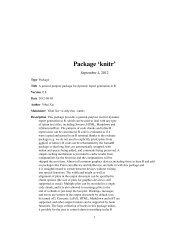Package 'openair'
Package 'openair'
Package 'openair'
Create successful ePaper yourself
Turn your PDF publications into a flip-book with our unique Google optimized e-Paper software.
10 calendarPlotannotatestatisticcolslimitslimcol.limfont.limcex.limdigitsThis option controls what appears on each day of the calendar. Can be: “date”— shows day of the month; “wd” — shows vector-averaged wind direction, or“ws” — shows vector-averaged wind direction scaled by wind speed. Finally itcan be “value” which shows the daily mean value.Statistic passed to timeAverage.Colours to be used for plotting. Options include “default”, “increment”, “heat”,“jet” and RColorBrewer colours — see the openair openColours functionfor more details. For user defined the user can supply a list of colour namesrecognised by R (type colours() to see the full list). An example would becols = c("yellow", "green", "blue")Use this option to manually set the colour scale limits. This is useful in the casewhen there is a need for two or more plots and a consistent scale is needed oneach. Set the limits to cover the maximimum range of the data for all plots ofinterest. For example, if one plot had data covering 0–60 and another 0–100,then set limits = c(0, 100). Note that data will be ignored if outside thelimits range.A threshold value to help differentiate values above and below lim. It is usedwhen annotate = "value". See next few options for control over the labelsused.For the annotation of concentration labels on each day. The first sets the colourof the text below lim and the second sets the colour of the text above lim.For the annotation of concentration labels on each day. The first sets the font ofthe text below lim and the second sets the font of the text above lim. Note thatfont = 1 is normal text and font = 2 is bold text.For the annotation of concentration labels on each day. The first sets the size ofthe text below lim and the second sets the size of the text above lim.The number of digits used to display concentration values when annotate = "value".data.thresh Data capture threshold passed to timeAverage. For example, data.thresh = 75means that at least 75% of the data must be available in a day for the value to becalculate, else the data is removed.labelsbreaksmainIf a categorical scale is required then these labels will be used. Note there is oneless label than break. For example, labels = c("good", "bad", "very bad").breaks must also be supplied if labels are given.If a categorical scale is required then these breaks will be used. For example,breaks = c(0, 50, 100, 1000). In this case “good” corresponds to valuesberween 0 and 50 and so on. Users should set the maximum value of breaks toexceed the maximum data value to ensure it is within the maximum final rangee.g. 100–1000 in this case.The plot title; default is pollutant and year.key.header Adds additional text/labels to the scale key. For example, passing calendarPlot(mydata, key.header =adds addition text above and below the scale key. These arguments are passedto drawOpenKey via quickText, applying the auto.text argument, to handleformatting.key.footersee key.header.
















